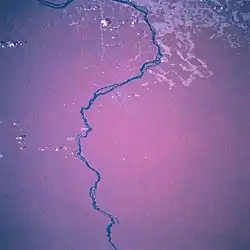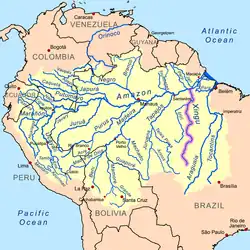| Xingu River | |
|---|---|
 Xingu River from space, downstream section. | |
 Map of the Amazon Basin with the Xingu River highlighted | |
| Native name | Byti (Kayapó) |
| Location | |
| Country | Brazil |
| Physical characteristics | |
| Mouth | Amazon River |
• coordinates | 1°31′59″S 52°14′30″W / 1.53306°S 52.24167°W |
| Length | 1,640 km (1,020 mi)[1] |
| Basin size | 520,300 km2 (200,900 sq mi) 513,313.5 km2 (198,191.5 sq mi)[2] |
| Discharge | |
| • location | Porto de Moz, Pará State (near mouth) |
| • average | 9,680 m3/s (342,000 cu ft/s) 10,022.591 m3/s (353,944.5 cu ft/s)[2] |
| Discharge | |
| • location | Altamira, Pará State (Basin size: 449,493 km2 (173,550 sq mi) |
| • average | (Period of data: 1970-1996)8,665 m3/s (306,000 cu ft/s)[3] 8,345.839 m3/s (294,730.5 cu ft/s)[2] |
| Discharge | |
| • location | Belo Horizonte, Pará State (Basin size: 277,265 km2 (107,053 sq mi) |
| • average | (Period of data: 1970-1996)5,324 m3/s (188,000 cu ft/s)[3] |
| Discharge | |
| • location | São Félix do Xingu, Pará State (Basin size: 250,626 km2 (96,767 sq mi) |
| • average | (Period of data: 1970-1996)4,627 m3/s (163,400 cu ft/s)[3] |
| Basin features | |
| Tributaries | |
| • left | Culuene, Curisevo, Tamitatoale, Ronuro, Manissauá-Miçu, Iriri, Pardo, Jaraucu |
| • right | Sete de Setembro, Suia-Miçu, Liberdade, Fresco, Bacaja |
The Xingu River (/ʃiːŋˈɡuː/ sheeng-GOO; Portuguese: Rio Xingu, Portuguese pronunciation: [ʃĩˈɡu]; Mẽbêngôkre: Byti, [bɯˈti][4]: 73 ) is a 1,640 km (1,019 mi)[1] river in north Brazil. It is a southeast tributary of the Amazon River and one of the largest clearwater rivers in the Amazon basin,[5] accounting for about 5% of its water.[6]
Description and history
The first Indigenous Park in Brazil was created in the river basin by the Brazilian government in the early 1960s. This park marks the first indigenous territory recognized by the Brazilian government and it was the world's largest indigenous preserve on the date of its creation. Currently, fourteen tribes live within Xingu Indigenous Park, surviving on natural resources and extracting from the river most of what they need for food and water.[7]
The Brazilian government is building the Belo Monte Dam, which will be the world's third-largest hydroelectric dam, on the Lower Xingu. Construction of this dam is under legal challenge by environment and indigenous groups, who assert the dam would have negative environmental and social impacts along with reducing the flow by up to 80% along a 100 km (60 mi) stretch known as the Volta Grande ("Big Bend").[8] The river flow in this stretch is highly complex and includes major sections of rapids.[9] More than 450 fish species have been documented in the Xingu River Basin and it is estimated that the total is around 600 fish species, including many endemics.[10] At least 193 fish species living in rapids are known from the lower Xingu,[9] and at least 26 of these are endemic.[11] From 2008 to 2018 alone, 24 new fish species have been described from the river.[9][11][12] Many species are seriously threatened by the dam, which will significantly alter the flow in the Volta Grande rapids.[9][13][14]
In the Upper Xingu region was a highly self-organized pre-Columbian anthropogenic landscape, including deposits of fertile agricultural terra preta, black soil in Portuguese, with a network of roads and polities each of which covered about 250 square kilometers.[15]
Near the source of Xingu River is Culuene River, a 600 kilometres (370 mi) tributary.[10][16]
In popular culture
- The name is the title of a humorous Edith Wharton short story from 1911.
- "Xingu" is the title of a song on Waterfall Cities, a 1999 album by Ozric Tentacles.
- The river is also honoured in the album Aguas da Amazonia.
- A beer produced near the river is sold in the international market under the name "Xingu".
- In the novel Relic by Douglas Preston and Lincoln Child, the Xingu River is the location of the doomed Whittlesey/Maxwell expedition responsible for discovering evidence of the lost Kothoga tribe and their savage god Mbwun.
- Xingu is a 2011 Brazilian movie, directed by Brazilian film-maker Cao Hamburger. The movie tells the story of the Villas-Bôas brothers 1943 expedition to the region, which led to the creation of the indigenous reserve twenty years later.
- The Embraer Xingu is a design of twin-engine airplane manufactured in the 1970s by Brazilian company Embraer.
See also
References
- 1 2 Ziesler, R.; Ardizzone, G.D. (1979). "Amazon River System". The Inland waters of Latin America. Food and Agriculture Organization of the United Nations. ISBN 92-5-000780-9. Archived from the original on 21 October 2013.
- 1 2 3 "Rivers Network". 2020. Archived from the original on 24 February 2022. Retrieved 24 February 2022.
- 1 2 3 Michael, T. Coe; Marcos, Heil Costa; Aurélie, Botta; Charon, Birkett (23 August 2002). "Long-term simulations of discharge and floods in the Amazon Basin". CiteSeerX 10.1.1.549.3854.
- ↑ Passos, João Lucas Moraes (2018). Caminhos mẽbêngôkre: andando, nomeando, sentando sobre a terra (Ph.D. dissertation). Brasília: Universidade de Brasília.
- ↑ Perez, M.S. "Where the Xingu Bends and Will Soon Break". American Scientist. Retrieved 1 October 2017.
- ↑ "Waters". Amazon Waters. Archived from the original on 29 June 2018. Retrieved 10 October 2017.
- ↑ "Xingu - Indigenous Peoples in Brazil". pib.socioambiental.org. Retrieved 25 September 2023.
- ↑ "Summary and History of the Belo Monte Dam: Rainforest Foundation" (PDF). Summary and History of the Belo Monte Dam: Rainforest Foundation. Archived from the original (PDF) on 6 January 2011. Retrieved 9 March 2011.
- 1 2 3 4 Fitzgerald; Perez; Sousa; Gonçalves; Py-Daniel; Lujan; Zuanon; Winemiller; Lundberg (2018). "Diversity and community structure of rapids-dwelling fishes of the Xingu River: Implications for conservation amid large-scale hydroelectric development". Biological Conservation. 222: 104–112. doi:10.1016/j.biocon.2018.04.002. S2CID 53625155.
- 1 2 Camargo, M., T. Giarrizzo and V. Isaac (2004). Review of the geographic distribution of fish fauna in the Xingu River Basin, Brazil. Ecotropica 10: 123–147
- 1 2 Hyland, T: Race against time. Retrieved 4 June 2014.
- ↑ Sousa, L.M.; M.S. Chaves; A. Akama; J. Zuanon; M.H. Sabaj (2018). "Platydoras birindellii, new species of striped raphael catfish (Siluriformes: Doradidae) from the Xingu Basin, Brazil". Proceedings of the Academy of Natural Sciences of Philadelphia. 166 (1): 1–13. doi:10.1635/053.166.0106. S2CID 90673235.
- ↑ Ekström, J. (23 December 2007) Hydroelectric dam constructions in Amazonas. Retrieved 10 February 2013.
- ↑ Survival International (2009). Experts Panel Assesses Belo Monte Dam Viability. Retrieved 10 February 2013.
- ↑ Heckenberger, Michael J.; J. Christian Russell; Carlos Fausto; Joshua R. Toney; Morgan J. Schmidt; Edithe Pereira; Bruna Franchetto; Afukaka Kuikuro (29 September 2008). "Pre-Columbian Urbanism, Anthropogenic Landscapes, and the Future of the Amazon". Science. American Association for the Advancement of Science. 321 (5893): 1214–1217. doi:10.1126/science.1159769. PMID 18755979. S2CID 41438038.
- ↑ Junk, Wolfgang J. (1997). The Central Amazon Floodplain: Ecology of a Pulsing System. Plön, Germany: Springer-Verlag Berlin Heidelberg. ISBN 978-3-64208214-6.
- Cowell, Adrian. 1973. The Tribe that Hides from Man. The Bodely Head, London.
- Original text from 1911 Encyclopædia Britannica
Further reading
- Heinsdijk, Dammis, and Ricardo Lemos Fróes. Description of Forest-Types on "Terra Firme" between the Rio Tapajós and the Rio Xingú in the Amazon Valley. 1956.
- Sipes, Ernest "Brazilian Indians: what FUNAI Won't Tell YOU". 2002.
- Brazilian Indians: What FUNAI Won't Tell You
External links
![]() Media related to Xingu River at Wikimedia Commons
Media related to Xingu River at Wikimedia Commons